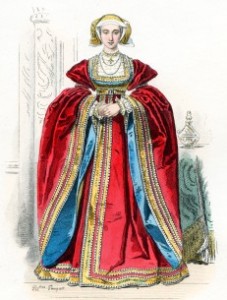
On this day in history, the 16th July 1557 (some sources say the 15th), Henry VIII’s fourth wife, Anne of Cleves died at her home, Chelsea Old Manor, the former home of Catherine Parr. She was only 41 but she was the last surviving wife of Henry VIII and had survived marriage to the King known for beheading two of his wives.
Anne of Cleves had been ill for a few months but by the 12th July she was bedridden and drafting her will. Elizabeth Norton writes of how her will “demonstrates her kindness and the fondness which she felt for her household”, because she left money to her ladies , gentlemen, yeomen, grooms and the children of the house, listing every member of her household by name, and also asked her step-daughter, Mary I, to make sure that the rents received from her lands at Michaelmas, would be used to meet the expenses of her household. Anne also bequeathed jewellery to her family, a ring to Catherine Brandon, Duchess of Suffolk, another ring to the Countess of Arundel and jewels to her stepdaughters, Mary and Elizabeth. In recompense for these jewels, she asked Mary to make sure that her servants were rewarded for their long service to her and she asked Elizabeth to take one of her maids into service.
Anne was no longer queen of England but her friend and stepdaughter, Mary I, made sure that she had the appropriate funeral for a woman of her status. Before her funeral, her coffin was covered with cloth-of-gold and surrounded by tapers which were burned day and night. Diarist Henry Machyn recorded that on the 3rd August 1557 Anne of Cleves was taken from Chelsea to Westminster to be buried:-
“The iij day of August my lade Anne of Cleyff, sumtyme wyff unto kyng Henry the viijth cam from Chelsey to be [buried] unto Westmynster, with all the chylderyn of Westmynster and [many] prest [priests] and clarkes, and then the gray ames [amice] of Powlles and iij crosses, and the monkes of Westmynster, and my lord bysshope of Lo[ndon] and my lord abbott of Westmynster rod together next the monkes, and then the ij sekturs [executors] ser Edmond Peckham and ser (Robert) Freston, cofferer to the quen of England; and then my lord admerall, my (lord) Darce of Essex, and mony knyghts and gentyllmen; and a-for her servandes, and after her baner of armes; and then her gentyllmen and here hed offesers; and then here charett with viij baners of armes of dyvers armes, and iiij baners of emages of whytt taffata, wroght with fyne gold and her armes; and so by sant James, and so to Charyingcrosse, with a C. torchys bornyng, her servandes beyrying them, and the xij bed-men of Westmynster had new blake gownes; and they had xij torchys bornyng, and iiij whyt branchys with armes; and then ladies and gentyll-women all in blake, and horsses; and a viij haroldes of armes in blake, and ther horses; and armes sad [set] a-bowt the herse behynd and be-for; and iiij haroldes barying the iiij whyt baners; and at (the) chyrche dore all dyd a-lyght and ther dyd reseyvyd the good lade my lord of London and my lord abbott in ther myteres and copes, sensyng her, and ther men dyd bere her with a canepe of blake welvett, with iiij blake stayffes, and so browth in-to the herse and ther tared durge, and so ther all nyght with lyght bornyng.”
Then, on the 4th of August, Machyn recorded that there was a requiem mass for “my lady prenses of Cleyff” with a “godly sermon” by the Lord Abbot of Westminster. Her coffin was then taken to her tomb and her body interred with the cloth-of-gold laid over her. Then, her head officers broke their staves and her ushers broke their rods and cast them into her tomb. After another mass, there was a dinner led by the chief mourner, Lady Winchester, the Lord Admiral and Lord Darcy. She is the only one of Henry VIII’s wives to be buried at Westminster Abbey and her tomb is on the south side of the High Altar. It is decorated with carvings of a crown and her initials, AC, skulls and crossed bones, and a lion’s head.
It is a sad fact that Anne, as Elizabeth Norton points out, “is often portrayed as the least significant of Henry’s wives” but that she was actually “an international figure of some prominence” and a woman who used her intelligence to survive the English court and become an independent woman. Just like Catherine of Aragon, she did not accept the annulment of her marriage and still thought of herself as Henry’s wife and Queen, and subsequently his widow, but she made the best out of the situation. RIP Anne of Cleves.
Fact: Like the rest of Henry VIII’s wives, Anne of Cleves was descended from Edward I, BUT, she was also descended from the Kings of France, through her father, and was a close relation of Louis XII of France and the Duke of Burgundy.
Notes and Sources
- Anne of Cleves: Henry VIII’s Discarded Bride by Elizabeth Norton
- The Diary of Henry Machyn: Citizen and Merchant-Taylor of London (1550-1563), 1557 July – Dec, p141-162
- Westminster Abbey page on Anne of Cleves